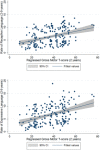Early gross motor skills predict the subsequent development of language in children with autism spectrum disorder
- PMID: 26692550
- PMCID: PMC5031219
- DOI: 10.1002/aur.1587
Early gross motor skills predict the subsequent development of language in children with autism spectrum disorder
Abstract
Background: Motor milestones such as the onset of walking are important developmental markers, not only for later motor skills but also for more widespread social-cognitive development. The aim of the current study was to test whether gross motor abilities, specifically the onset of walking, predicted the subsequent rate of language development in a large cohort of children with autism spectrum disorder (ASD).
Methods: We ran growth curve models for expressive and receptive language measured at 2, 3, 5 and 9 years in 209 autistic children. Measures of gross motor, visual reception and autism symptoms were collected at the 2 year visit. In Model 1, walking onset was included as a predictor of the slope of language development. Model 2 included a measure of non-verbal IQ and autism symptom severity as covariates. The final model, Model 3, additionally covaried for gross motor ability.
Results: In the first model, parent-reported age of walking onset significantly predicted the subsequent rate of language development although the relationship became non-significant when gross motor skill, non-verbal ability and autism severity scores were included (Models 2 & 3). Gross motor score, however, did remain a significant predictor of both expressive and receptive language development.
Conclusions: Taken together, the model results provide some evidence that early motor abilities in young children with ASD can have longitudinal cross-domain influences, potentially contributing, in part, to the linguistic difficulties that characterise ASD. Autism Res 2016, 9: 993-1001. © 2015 The Authors Autism Research published by Wiley Periodicals, Inc. on behalf of International Society for Autism Research.
Keywords: autism spectrum disorder; language development; walking.
© 2015 The Authors Autism Research published by Wiley Periodicals, Inc. on behalf of International Society for Autism Research.
Figures
References
-
- Adolph, K.E. , & Robinson, S.R. (2013). The road to walking: What learning to walk tells us about development In Zelazo P. (Ed.), Oxford Handbook of Developmental Psychology. NY: Oxford University Press.
-
- Alcock, K.J. , & Krawczyk, K. (2010). Individual differences in language development: Relationship with motor skill at 21 months. Developmental Science, 13, 677–691. - PubMed
-
- American Psychiatric Association (2013). Diagnostic and statistical manual of mental disorders (5th Edition). Washington, DC: American Psychiatric Association.
-
- Baker, N. , & Nelson, K.E. (1984). Recasting and related conversational techniques for triggering syntactic advances in young children. First Language, 5, 3–22.
-
- Bayley, N. (1993). Bayley Scales of Infant Development—2nd edition. San Antonio, TX: Psychological Corporation.
MeSH terms
Grants and funding
LinkOut - more resources
Full Text Sources
Other Literature Sources
Medical
Miscellaneous



